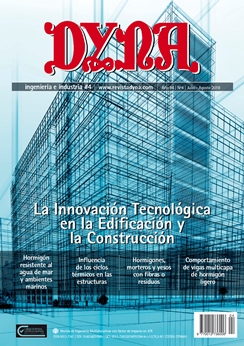EXPERIMENTAL ASSESSMENT OF THE TENSILE AND SHEAR STRENGTH BEHAVIOUR OF POLYOLEFIN FIBRE REINFORCED CONCRETE
Keywords:
Hormigón reforzado con fibras de poliolefina (HRFP), uniaxial, "push-off", vídeo-extensometría, Polyolefin fibre reinforced concrete, digital image correlation.Abstract
In the last decades, certain types of non-metallic fibres have been found suitable for structural concrete elements achieving analogous performance of steel fibres. Among such non-metallic fibres, polyolefin macro-fibres can meet the requirements set in the standards in order to consider their contribution in the structural design. However, EHE-08 consider the constitutive models based on steel fibre reinforced concrete as the reference for other fibres. Previous experimental campaigns carried out with polyolefin fibre reinforced concrete (PFRC) have evaluated their flexural fracture behaviour, with several amounts of fibre dosages. In addition, their constitutive models have been found. Given that the structural requirements were set based on the results obtained following UNE-EN 14651:2007+A1 that only considers the flexural behaviour, the contributions of the fibres when the structural element is subjected to more complex stress states is a matter that deserves being further studied. The main objective of this contribution was to assess the performance of PFRC subjected to tensile stresses and shear stresses. This was carried out developing uniaxial tensile tests and push-off tests. In order to do so the remaining halves of PFRC samples already tested following UNE-EN 14651 were used. Two PFRC formulations were studied, one with 6kg/m³ of fibres and another with 7.5kg/m³ of fibres. In both cases 48mm-long fibres were added. These tests were also recorded in order to analyse the damage patterns and the appearance, growing and coalescence of cracks by means of digital image correlations techniques. Non-standardised test results showed a remarkable PFRC behaviour both under tensile and shear stresses. Such results together with the flexural behaviour previouses found confirmed the suitability of PFRC as a structural material. In addition, the test results widened the knowledge of the mechanical response of PFRC under complex stress states.Downloads
Published
2019-07-01
Issue
Section
ARTICULOS

